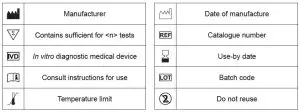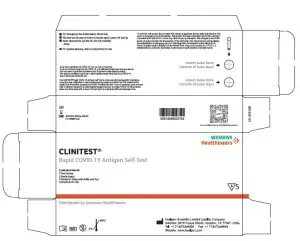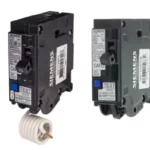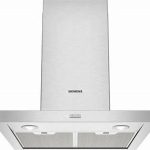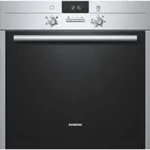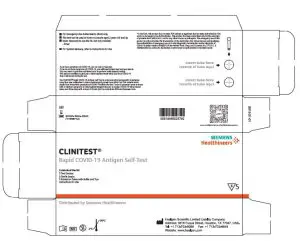
SIEMENS Clinitest Rapid Covid-19 Antigen Self-Test Instructions
For Emergency Use Authorization (EUA) Only. In vitro diagnostic use only.
In the USA, this product has not been FDA cleared or approved; but has been authorized by FDA under an Emergency Use Authorization. This product has been authorized only for the detection of proteins from SARS-CoV-2, not for any other viruses or pathogens. The emergency use of this product is only authorized for the duration of the declaration that circumstances exist justifying the authorization of emergency use of in vitro diagnostics for detection and/or diagnosis of COVID-19 under Section 564(b)(1) of the Federal Food, Drug, and
Cosmetic Act, 21 U.S.C. § 360bbb-3(b)(1), unless the declaration is terminated or authorization is revoked sooner.
INTRODUCT ION
IMPORTANT
- Read instructions carefully before starting the test. – For non-prescription home use with self-collected anterior nasal swab samples from individuals aged 14 years or older, or adult-collected anterior nasal swab samples from individuals aged 2 years or older with symptoms of COVID-19 within the first 7 days of symptom onset. Also for non-prescription home use with self-collected anterior nasal swab samples from individuals aged 14 years or older, or adult-collected anterior nasal swab samples from individuals aged 2 years or older, with or without symptoms or other epidemiological reasons to suspect COVID-19 when tested twice over three days with at least 24 hours (and no more than 48 hours) between tests.
- Test setup is about 5 minutes. The result must be read at 15 minutes.
- All test materials must be at room temperature before use.
- You should wear a face mask if swabbing others.
- You must follow the test directions carefully to get an accurate result. If you have any questions about using the test or reading the results please call our customer care hotline.
Telephone: 1-833-933-2340 E-Mail: [email protected] www.clinitest.siemens-healthineers.com/us.
WASH HANDS
Wash your hands with soap and water for 30 seconds or use hand sanitizer. Make sure hands are dry before starting.
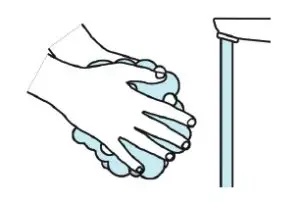
GATHER MATERIALS
Check expiration date of the test kit before use. Expiration date is printed on the box and each test pouch. Do not use if test is expired.
PREP
Remove all contents in the box. Read instructions.
Do not start Step 1 until you are ready to begin the test.
STEP 1.
PLACE TUBE IN TUBE HOLDER
Find tube holder shown on the back of the box. Push tube through outlined hole.

STEP 2.
OPEN TUBE
Remove the seal from the tube. Avoid spilling the liquid. Make sure the tube is standing up straight.

STEP 3.
OPEN SWAB PLACE TUBE IN TUBE HOLDER
Find tube holder shown on the back of the box. Push tube through outlined hole.
Open the swab pouch on the end opposite the swab tip by peeling back the pouch cover.
Hold the plastic stick end of the swab and remove from pouch. Be careful not to touch the tip of the swab.
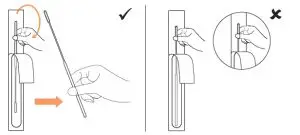
SWAB BOTH NOSTRILS
Carefully insert swab tip into one nostril about 1/2 to 3/4 of an inch deep.
Do not insert the swab any further if you feel any resistance. Rub the insides of the nostril in a complete circle at least 5 times. Make sure that you are rubbing the insides of the nostril. Take approximately 15 seconds to collect the specimen.
Be sure to collect any nasal drainage that may be present on the swab. Remove swab from the nostril and repeat in your other nostril.
NOTE: If you are swabbing others, please wear a face mask. With children, you may not need to insert the swab as far into the nostril. For very young children, you may need another person to steady the child’s head while swabbing.
NOTE: Failure to swab properly may cause false negative results.
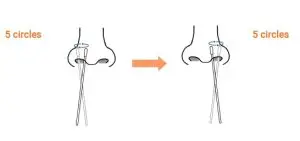
STEP 4.
PLACE SWAB IN TUBE
Remove the swab from your nostril. Immediately take the tube out of the tube holder and insert swab tip into the liquid inside the tube. Mix vigorously
by rolling the swab tip at least 6 times on the bottom and sides of the tube.
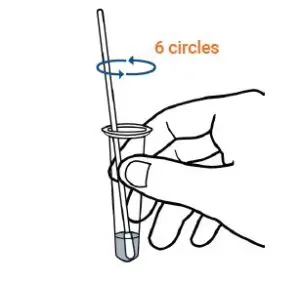
PLACE TUBE IN TUBE HOLDER
Place the tube back into the tube holder. Keep the swab inside of the tube. Start timer for 1 minute.
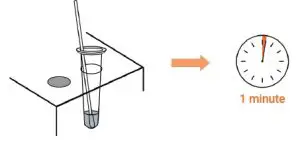
REMOVE SWAB FROM TUBE
After 1 minute take the tube out of the tube holder. As you remove the swab from the tube, squeeze swab tip several times from outside of the tube. Try to release as much liquid from the swab as possible.
Dispose the swab in the trash.
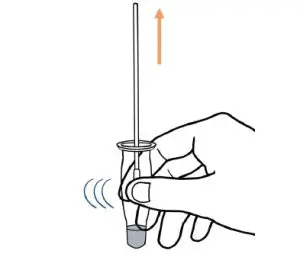
INSERT TIP
Take a tube tip from the kit and push it into the top of the tube. Make sure there is a tight fit.
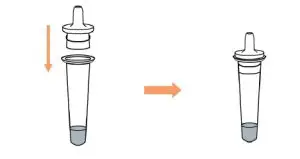
STEP 5.
OPEN TEST DEVICE
Open the test device pouch by tearing the area circled below. Place the test device on a flat surface.

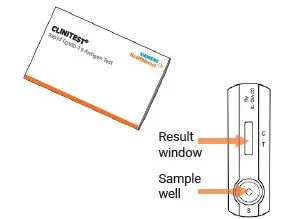
ADD 4 DROPS
Hold the tube straight up and down above the test device and gently squeeze to add 4 drops of solution into the sample well, labeled as “S” on the test device. Adding more or less than 4 drops of solution into the sample well may result in incorrect results.
START TIMER
Start timer for 15 minutes.
Do not move the test device. Keep on a flat surface.
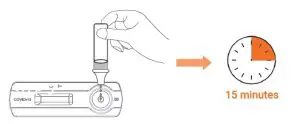
STEP 6.
READ TEST RESULT
After 15 minutes find result window, labeled as “C” (for Control) and “T” (for Test) on the test device. It is important to read your test result at 15-20 minutes.
False negative or false positive results can occur if test results are read before 15 minutes or after 30 minutes.
Below are examples for positive, negative and invalid test results. Used test materials should be thrown away as household waste.
COVID-19 POSITIVE
If the test device looks like the examples below, then protein from the virus that causes COVID-19 was detected in the sample. The test is positive if there are two pink/red lines present, one at the Control “C” line and one at the Test “T” line. Look very closely for line next to “T”. This line can be very faint. Any visible pink/red “T” line is a positive result when the “C” line is also present.
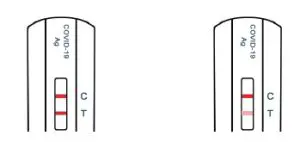
IF THE TEST IS POSITIVE
A positive test result means that the virus that causes COVID-19 was detected in your sample and it is very likely you have COVID-19 and it is important to be under the care of a healthcare provider. It is likely you will be asked to isolate yourself at home to avoid spreading the virus to others. There is a very small chance that this test can give a positive result that is incorrect (a false positive). If you test positive with the CLINITEST Rapid COVID-19 Antigen Self-Test you should self-isolate and seek follow-up care with your healthcare provider as additional testing may be necessary. Your healthcare provider will work with you to determine how best to care for you based on your test results along with medical history and your symptoms.
COVID-19 NEGATIVE
If the test device looks like the example below then protein from the virus that causes COVID-19 was not detected. You will only see one line next to “C” and there will not be any line visible next to”T”.
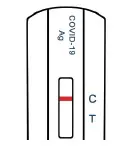
IF THE TEST IS NEGATIVE
A negative test result means that protein from the virus that causes COVID-19 was not detected in your sample. If you took this test while you have symptoms, a negative test result usually means that your current illness was not caused by COVID-19. However, it is possible for this test to give a negative result that is incorrect (a false negative) in some people with COVID-19. Negative results do not rule out COVID-19. This means you could possibly still have COVID-19 even though the test is negative. If you test negative and continue to experience
COVID-19-like symptoms of fever, cough and/or shortness of breath, you should seek follow up care with your healthcare provider. Your healthcare provider will consider the test result with all other aspects of your history such as symptoms and possible exposures to decide how to care for you.
For example, your healthcare provider may suggest you need another test to determine if you have the virus causing COVID-19. It is important you work with your healthcare provider to help you understand the next steps you should take. If you DO NOT have COVID-19 symptoms and your result is negative, you should test again with at least 24 hours and no more than 48 hours between tests. If
both your first an second test results are negative, you may not have COVID-19.
INVALID
If the test device looks like the examples below then the test was not able to give a result and you must repeat the test with a new swab, a new tube, and
a new test device. The test is INVALID if there is no line next to “C”.
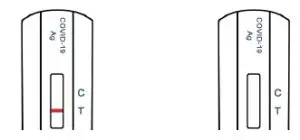
IF THE TEST IS INVALID
If at 15 minutes the line next to the “C” does not appear, even if any shade of pink/red “T” line appears, the test result is invalid. If the test result is invalid, a new swab should be collected, and the test should be performed again with a new tube and test device.
For FDA Emergency Use Authorization (EUA) Only
- For more information on EUAs please visit: https://www.fda.gov/emergency-preparedness-andresponse/ mcm-legal-regulatory-and-policy-framework/emergency-use-authorization
- For the most up to date information on COVID-19, please visit: www.cdc.gov/COVID19
- For detailed instructions, please visit: www.clinitest.siemens-healthineers.com/us.
Intended Use
The CLINITEST® Rapid COVID-19 Antigen Self-Test is a lateral flow chromatographic immunoassay intended for the qualitative detection of nucleocapsid protein antigen from SARS-CoV-2. This test is authorized for non-prescription home use with self-collected anterior nasal (nares) swab samples from individuals aged 14 years or older with symptoms of COVID-19 within the first 7 days of symptom onset. This test is also authorized for non-prescription home use with adult-collected anterior nasal (nares) swab samples from individuals aged 2 years or older with symptoms of COVID-19 within the first 7 days of symptom onset. This test is also authorized for non-prescription home use with self-collected anterior nasal (nares) swab samples from individuals aged 14 years or older, or adult-collected anterior nasal (nares) swab samples from individuals aged 2 years or older, with or without symptoms or other epidemiological reasons to suspect COVID-19 when tested twice over three days with at least 24 hours (and no more than 48 hours) between tests.
The CLINITEST® Rapid COVID-19 Antigen Self-Test does not differentiate between SARS-CoV and SARS-CoV-2.
Results are for the identification of SARS-CoV-2 nucleocapsid protein antigen. Antigen is generally detectable in anterior nasal (nares) swabs during the acute phase of infection. Positive results indicate the presence of viral antigens, but clinical correlation with past medical history and other diagnostic information is necessary to determine infection status. Positive results do not rule out bacterial infection or co-infection with other viruses. The agent detected may not be the definite cause of disease. Individuals who test positive with CLINITEST® Rapid COVID-19 Antigen Self-Test should self-isolate and seek
follow-up care with their physician or healthcare provider as additional testing may be necessary.
Negative results should be treated as presumptive and confirmation with a molecular assay, if necessary, for patient management, may be performed. Negative results do not rule out SARS-CoV-2 infection and should not be used as the sole basis for treatment or patient management decisions, including infection control decisions. Negative results should be
considered in the context of an individual’s recent exposures, history, and the presence of clinical signs and symptoms consistent with COVID-19.
For serial testing programs, additional confirmatory testing with a molecular test for negative results may be necessary, if there is a high likelihood of COVID-19, such as in an individual with a close contact with COVID-19 or with suspected exposure to COVID-19 or in communities with high prevalence of infection. Additional confirmatory testing with a molecular test for
positive results may also be necessary, if there is a low likelihood of COVID-19, such as in individuals without known exposures to COVID-19 or residing in communities with low prevalence of infection.
Individuals who test negative and continue to experience COVID-like symptoms of fever, cough and/or shortness of breath may still have SARS-CoV-2 infection and should seek follow up care from their healthcare provider. Individuals should provide all results obtained with this product to their healthcare provider for public health reporting. All healthcare providers will report all test results they receive from individuals who use the authorized product to relevant public health authorities in accordance with local, state, and federal requirements using appropriate LOINC and SNOMED codes, as
defined by the Laboratory In Vitro Diagnostics (LIVD) Test Code Mapping for SARS-CoV-2 Tests provided by CDC.
The CLINITEST® Rapid COVID-19 Antigen Self-Test is intended for non-prescription self-use and/or, as applicable, for an adult lay user testing another aged 2 years or older. The CLINITEST® Rapid COVID-19 Antigen Self-Test is only for use under the Food and Drug Administration’s Emergency Use Authorization.
Warnings, Precautions, and Safety Information
Read the CLINITEST® Rapid COVID-19 Antigen Self-Test Package Insert carefully before performing a test. Failure to follow directions may produce inaccurate test results.
- Follow directions for use.
- The Test is intended to aid in the diagnosis of a current COVID-19 infection. Please consult a healthcare professional to discuss your results and if any additional testing is required.
- Keep test kit and materials out of the reach of children and pets before and after use.
- You should wear a face mask if swabbing others.
- This test is read visually. Users with impaired vision or color-impaired vision may not be able to read the test.
- Children aged 2 to 13 years of age should be tested by an adult.
- The control line may show up within a few minutes of starting the test. It may take up to 15 minutes for a test line to show up.
- Do not use on anyone under two years of age.
- Do not open the kit contents until ready for use. If the test cassette is open for an hour or longer, invalid test results may occur.
- Do not use the test after the expiration date shown on the test cassette pouch.
- Do not use if any of the test kit contents or packaging is damaged or open.
- Test components are single-use. Do not re-use.
- Make sure there is sufficient light when testing. For best results, read test in a well-lit area.
- Do not use nasal sprays for at least 30 minutes before collecting a nasal sample.
- Remove any piercings from the nose before starting the test.
- Do not use on anyone who is prone to nosebleeds or has had facial injuries or head injuries/surgery in the past six months.
- Inadequate or improper nasal swab sample collection may yield false negative test results.
- Do not touch the swab tip (specimen collection area) when handling the swab.
- The test is intended to be read at 15 minutes. If the test is read before 15 minutes or after 30 minutes, false negative or false positive results may occur, and the test should be repeated with a new test cassette.
- Do not ingest any kit components.
- Avoid exposure of your skin, eyes, nose, or mouth to the solution in the tube.
- The solution in the tube and the test device contains an ingredient that is hazardous to skin and eyes (see table below). If contact with the body occurs, rinse with water. If irritation persists, seek medical advice. https://www.poison.org/contact-us or 1-800-222-1222
| Chemical Name/CAS | GHS Code for applicable Ingredient | Concentration (%) |
| Sodium Azide/26628-22-8 | Acute Tox. 2 (Oral), H300 Acute Tox. 1 (Dermal), H310 | 0.02% (device)
and 0.05% (tube) |
| Triton/9002-93-1 | Acute Tox. 4 (Oral), H302 | 1.5% |
Serial Testing Information and Limitations
- If you have symptoms of COVID-19 that started within the last 7 days, you can use a single test.
- Testing for asymptomatic individuals should be performed at least twice over three days, with at least 24 hours and no more than 48 hours between tests. You may need to purchase additional tests to perform this serial (repeat) testing. For serial testing, if your first test result is negative, you should test again with a new test in 24 to 48 hours.
- Serial testing (i.e., testing every day or every other day) is more likely to detect COVID-19, especially when you do not have any symptoms.
- If your first or second test is positive, then proteins from the virus that causes COVID-19 have been found in your sample and you likely have COVID-19.
- If both your first and second tests are negative, you may not have COVID-19, however you should follow-up with your healthcare provider if you are at high risk for COVID-19.
Frequently Asked Questions
Q: WHAT IS COVID-19?
A: COVID-19 is an acute respiratory infectious
disease caused by the SARS-CoV-2 virus, a novel Betacoronavirus. SARS-CoV-2 is mostly spread person-to-person, both by individuals with symptoms of COVID-19 infection and by infected people without symptoms. Based on the current knowledge, the incubation period is 1 to 14 days, mostly 4-5 days. Symptoms include fever, fatigue, and cough.
For a full list of symptoms, see: https://www.cdc.gov/coronavirus/2019-ncov/symptoms-testing/symptoms.html.
Q: WILL THIS TEST HURT?
A: No, the nasal swab is not sharp, and it should not hurt. Sometimes the swab can feel slightly uncomfortable.
If you feel pain, please stop the test and seek advice from your healthcare provider.
Q: WHAT ARE THE KNOWN POTENTIAL RISKS AND BENEFITS OF THIS TEST?
A: Potential risks include:
- Possible discomfort during sample collection.
- Possible incorrect test results (see Result Interpretation section). Potential benefits include:
- The results, along with other information, can help you and your healthcare provider make informed decisions about your care.
- The results of this test may help limit the spread of COVID-19 to your family and others in your community.
Q: WHAT IS SERIAL TESTING?
A: Serial testing is when one person tests themselves multiple times for COVID-19 on a routine basis, such as every day or every other day. By testing more frequently, you may detect COVID-19 more quickly and reduce spread of infection. Serial testing (i.e. testing every day or every other day) is more likely to detect COVID-19, especially when you do not have any symptoms. Testing for asymptomatic individuals should be performed at least twice over three days, with at least twenty-four hours and no more than 48 hours between tests. You may need to purchase additional tests to perform this
serial (repeat) testing.
Q: WHAT IS THE DIFFERENCE BETWEEN AN ANTIGEN AND MOLECULAR TEST?
A: There are different kinds of tests for the virus that causes COVID-19. Molecular tests detect genetic material from the virus.
Antigen tests, such as the CLINITEST® Rapid COVID-19 Antigen Self-Test, detect proteins from the virus. Antigen tests are very specific for the SARS-CoV-2 virus but are not as sensitive as molecular tests. This means that a positive result is highly accurate, but a negative result does not rule out infection. If your test result is negative, you should discuss with your healthcare provider whether an additional test is necessary and if you should continue isolating at home. There is a higher chance of false negative results with antigen tests than with laboratory-based molecular tests. This means that there is a
higher chance this test will give you a negative result when you have COVID-19.
Q: HOW ACCURATE IS THIS TEST?
A: A clinical evaluation comparing the CLINITEST® Rapid COVID-19 Antigen Self-Test to an EUA authorized Molecular
SARS-COV-2 test was conducted. For clinical evaluation results please use the following QR code or web address.
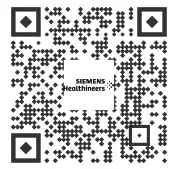
The performance of this test is still being studied in patients without signs and symptoms of respiratory infection and for serial screening. Performance may differ in these populations.
Q: WHAT IF YOU TEST POSITIVE?
A: A positive test result means that antigens from the virus that causes COVID-19 were detected and it is very likely you currently have COVID-19. If you test positive you should self-isolate at home per CDC recommendations to stop spreading the virus to others. Please consult the CDC recommendations regarding self-isolation at www.cdc.gov/coronavirus. There is
a chance that this test can give a positive result that is wrong (a false positive result). Seek follow-up care with your healthcare provider immediately. Your healthcare provider will work with you to determine how best to care for you based on your test result(s) along with your medical history, and your symptoms.
Q: WHAT IF YOU TEST NEGATIVE?
A: A negative test result indicates that antigens from the virus that causes COVID-19 were not found in your sample. If you have symptoms, you likely do not have COVID-19. If you do not have symptoms and you receive a second negative result 24 to 48 hours after your first negative result, then you are likely not infected with COVID-19. However, negative results do not rule out SARS-CoV-2 infection.
It is possible for this test to give a negative result that is incorrect (false negative) in some people with COVID-19. This means that you could possibly still have COVID-19 even though the test is negative. For example, you may get a false negative result if you did not perform the test correctly or if the level of antigen from the virus causing COVID-19 was below the test limits. The amount of antigen in a sample may decrease the longer you have symptoms of infection. If you test negative and continue to experience symptoms of fever, cough and/or shortness of breath you should seek follow up
care with your healthcare provider. Your healthcare provider will consider the test result together with all other aspects of your medical history (such as symptoms, possible exposures, and geographical location of places you have recently traveled) in deciding how to care for you. Your healthcare provider may suggest you need another test to determine if you have contracted the virus causing COVID-19.
It is important that you work with your healthcare provider to help you understand the next steps you should take.
The performance of this test was established based on the evaluation of a limited number of clinical specimens. Clinical performance has not been established with all circulating variants but is anticipated to be reflective of the prevalent variants in circulation at the time and location of the clinical evaluation. Performance at the time of testing may vary depending on the variants circulating, including newly emerging strains of SARSCoV-2 and their prevalence, which change over time.
Q: WHAT DOES AN INVALID TEST RESULT MEAN?
A: If no control line shows up on the test, the result is invalid (even if any test line shows up). An invalid result means the test was not able to tell if you have COVID-19 or not. If the test is invalid, a new swab should be used to collect a new nasal specimen and the test should be run again, using a new test and tube.
Important
This test is intended to be used as an aid in the clinical diagnosis of a current COVID-19 infection. Do not use this test as the only guide to manage your illness. Please consult your healthcare provider if your symptoms persist or become more severe, or if you are concerned at any time.
Individuals should provide all results obtained with this product to their healthcare provider for public health reporting.
Healthcare Providers
Please visit www.clinitest.siemens-healthineers.com/us to obtain the complete instructions for use and fact sheet for healthcare providers.
Index of Symbols
